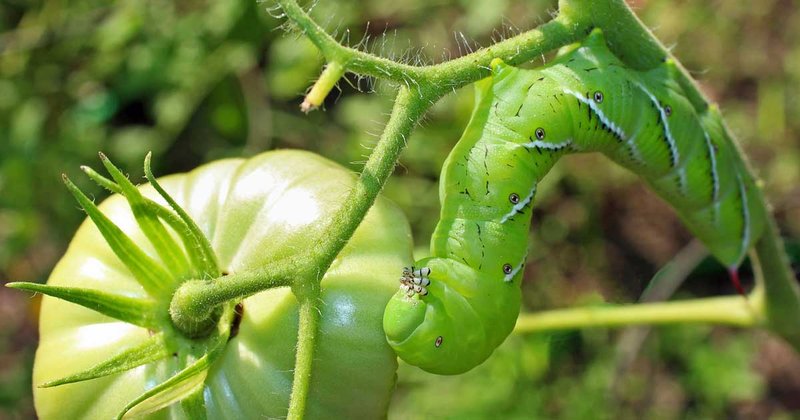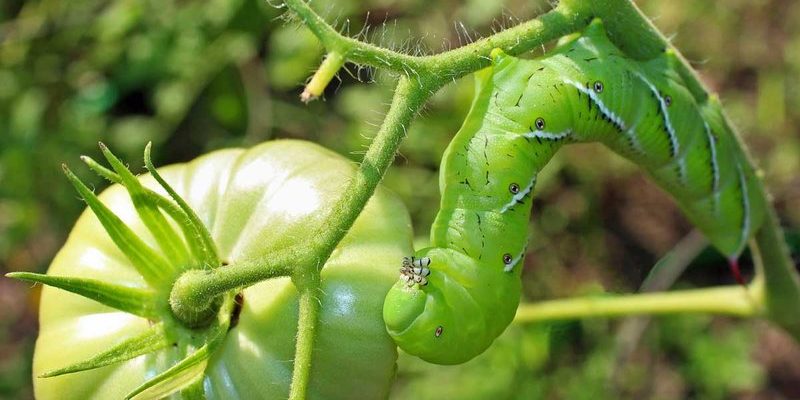
Tomato hornworms are the larval stage of large moths known as *Manduca quinquemaculata*. They’re about the size of your pinky finger, with a striking green color that helps them blend in with the tomato leaves. Almost like a stealth ninja, these pests can cause significant damage before you even realize they’re there. Learning to spot them early can save your precious tomato crop.
Now, let’s break down the key elements of identifying these pests, and I’ll share tips on how to manage them if they decide to crash your garden party.
What Do Tomato Hornworms Look Like?
When it comes to identifying tomato hornworms, their appearance is your first clue. These caterpillars can grow between 3 to 4 inches long, and they sport a slender, bright green body that mimics the color of tomato leaves. This camouflage is one of the reasons why they can go unnoticed, at least until they’ve had their fill of plant foliage.
One of the most distinctive features of tomato hornworms is the horn-like projection on their rear end, which gives them their name. They also have diagonal stripes running down their sides, usually a lighter green or yellowish tone. Once you know what to look for, spotting them becomes a bit easier.
Another tip? Check the undersides of leaves for signs of munching. Hornworms are notorious for their voracious appetite, so you might notice irregular holes or stripped foliage. If you see these signs, it’s time for a closer inspection of your plants.
Where to Look for Tomato Hornworms
Finding tomato hornworms can take a little detective work. They tend to feed during the night, making them less active during the day when you’re most likely to be in the garden. However, that doesn’t mean they’re hard to find! **Observe the plant closely**.
Start at the base of the plant and work your way up. Check the **undersides of the leaves**, as this is often where they hide. If your tomato plants are big enough, you might need to gently shake or tap the branches to coax the hornworms out from their hiding spots. You might be surprised at how many you find if you look closely!
It’s also worth noting that hornworms tend to prefer certain plants. If you have a variety of tomato types, they’ll often go for those that are healthier or more lush. Another reason to stay vigilant!
Signs of Tomato Hornworm Damage
Picture this: you step out to admire your tomatoes, expecting ripe fruit and lush green leaves. Instead, you find bare stems and shredded leaves. That’s a classic sign of tomato hornworms at work.
They not only chew through the leaves but can also damage the fruit itself. Look for:
- Large, irregular holes in the leaves
- Discoloration or wilting of the plant
- Fruit that has bite marks or scars
Damage can escalate quickly. A single hornworm can devour an entire leaf in a matter of hours. If you spot any of these signs, don’t wait—check for hornworms right away!
How to Control Tomato Hornworms
So, you’ve spotted some hornworms. Now what? Controlling them can be done in several ways, and you’ll want to pick the method that suits your gardening style. Here are some effective strategies:
1. **Manual Removal**: This method is straightforward and effective. Simply pick them off your plants by hand. Don’t worry; they’re not dangerous, and it’s a good way to get up close and personal with your plants. Make sure to check for eggs as well, which can look like small, green clusters near the leaves.
2. **Natural Predators**: Consider introducing beneficial insects to your garden. **Parasitic wasps** are one such predator. They lay eggs in hornworm bodies, which eventually leads to the death of the caterpillar. This might sound a bit gruesome, but it’s a natural balance in the ecosystem!
3. **Insecticidal Soap**: If you’re dealing with a more significant infestation, you might want to consider organic insecticidal soap. It targets soft-bodied insects and is safe to use on your plants. Just be sure to follow the instructions and only use it when necessary.
Why Early Detection Matters
Identifying tomato hornworms early on can save your garden a lot of grief. These pests can reproduce quickly, meaning a small problem can turn into a full-blown infestation in just a few days. Recognizing the signs of their presence early allows you to take action before your tomato plants are significantly damaged.
Here’s the thing: it’s not just about protecting your plants; it’s also about preserving your hard work and investment. Gardening takes time and care. By staying vigilant and proactive, you can help ensure that your efforts don’t go to waste.
Also, early detection means you can have a more targeted response, saving you time and effort compared to dealing with a larger problem later.
Tips for Preventing Tomato Hornworm Infestations
Prevention often beats reaction. To keep hornworms at bay, consider these strategies:
– **Crop Rotation**: Changing where you plant your tomatoes each year can disrupt the life cycle of hornworms. This makes it harder for them to find their preferred food source.
– **Healthy Plants**: Well-nourished plants are less likely to suffer from severe infestations. Make sure your tomatoes get adequate sunlight, water, and nutrients.
– **Trap Crops**: Planting extra tomatoes or other crops that attract hornworms can draw them away from your main plants. This way, you can manage them more easily.
Following these tips can create a healthy environment for your tomatoes while keeping those pesky hornworms at bay.
Identifying tomato hornworms is an essential skill for any veggie gardener. Recognizing what they look like, where to find them, and understanding their damage can save your garden from severe losses. Early detection, manual removal, and prevention strategies can set you up for a successful tomato harvest.
So, the next time you stroll through your garden, take a moment to look closely at your plants. Just like we enjoy a good meal, your tomatoes deserve the same respect. By being vigilant, you’ll ensure your garden stays healthy and productive, free from those sneaky little munchers. Happy gardening!

